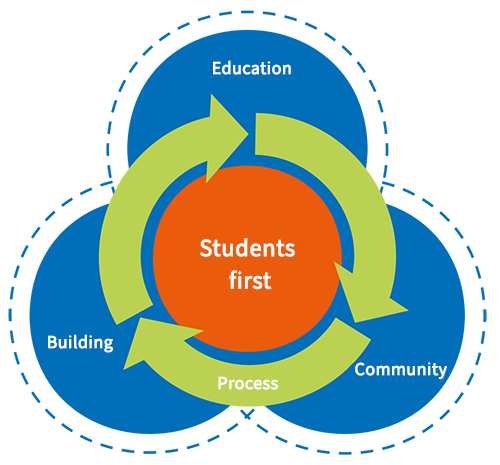The Green Flag is an accreditation for schools that consistently take sustainable steps-large or small- while putting their students first. With their actions, they will give sustainability a prominent spot in their education, building and surroundings. Everybody in and around the school is welcome to participate on the transition. Together, these aspects form the five pillars of the Eco-Schools philosophy:
- Pupils take center stage (pupils focus point)
- The school always takes sustainable steps - large or small (process)
- Sustainability has a permanent place in education (education)
- Sustainability is visible in the building and the surroundings (building)
- Everyone in and around the school participates (community)
The international accreditation for sustainable schools
Schools that actively work on the five pillars, are eligible for the Green flag. This is the international accreditation for sustainable schools. Raising the flag is a festive moment! The students and teachers are in the spotlight, while the parents, neighborhood and local parties enjoy the event. It takes more or less two years to obtain the Green Flag. Throughout a portfolio the Eco-team is able to present what they have accomplished. In order to preserve the Green Flag, the school has to keep on developing. Every two years a new accreditation takes place.
Making a difference as a frontrunner
We do not see sustainability as a destination but as a continuous journey of discovery that we embark on together. The accreditation of Eco-Schools, the Green-Flag, will be granted to schools who contribute to this development. At the audit we will of course look at your marvelous results but the focus lays primarily on the development that you go through as a school. You are the frontrunners driving the sustainability movement in schools! This is not always easy. We are facing with people that come from other perspectives or beliefs, who feel less urgency or who simply cannot find the time and energy to delve into how things can be done differently. That is why our work is so important as pioneers.
We want to fully support all the motivation and willingness to take action. There are for instance sometimes schools that hold a little group of enthusiasts who can achieve a lot together. On the other hand, there are also schools where it’s a bit harder to cooperate. Eco-Schools want to support every school and Eco-team on their own ambition and level, in order to continuously grow together. This is why we apply different ambition levels.
Ambition levels
The road to a sustainable school can be quite different for each school. For example, the starting point for each school is different, the context is different and each school encounters different challenges. In addition, it varies per Eco-team how they relate to their surroundings: are there more plants, trees, and animals nearby, or is the tree standing by itself? Eco-Schools consist of four ambition levels: tree, garden, park and forest.

The figures above illustrate the ambition levels. They symbolize the place of the Eco-team (the tree) within the school. Hereby, you as a team focus on how much biodiversity there is in and around the tree. How many people are participating, how are they organized, and how much cohesion is there between different initiatives? The garden symbolizes a larger ground. How much biodiversity is there in and around the garden, how many people are involved? When an Eco-team wants to focus on a larger spectrum they can think of how much biodiversity there is in a park or even a forest. Each school takes different steps, measured by the level of their own ambition.
The reward for your work
When you apply for the Green Flag, you will show throughout your portfolio, how you have been working on Eco-schools’ five pillars. You will also reflect on your progress and achieved results. Are you working alone, like a tree, as your own Eco-team? Or is thinking/acting sustainably a part of your schools' culture? During the Green Flag audit visit, we will take a look at your projects and speak to people from school. Based on that we will provide tips and recommendations for the next step. Regardless of what your situation might be: the Green Flag is a reward for the work you delivered and everyone who participated in your development.
Audits
On the path to the first Green Flag, two audits take place: for the Bronze certificate and the Silver certificate. With these certificates you show that your school is on its way to the Green Flag.
The audit for the Bronze certificate can be requested after completing steps 1 to 4. For most schools this is one year after the start. The Silver certificate can be applied for after going through step 5. This is approximately six months after obtaining the Bronze certificate.
To be eligible for these certificates you request an audit via 'My Eco-Schools' on this website. Eco-Schools The Netherlands carry out the audits. We do this at the office, based on the documentens you uploaded via the audit page on 'My Eco-Schools'. After the audit you receive a report from us, in which we look back on what you have done and give recommendations for the next steps.
You can apply for the Green Flag as a school after completing all seven steps. You can also apply for this audit via your own login page on this website. For this an auditor from Eco-Schools The Netherlands will visit your school. After the audit you will receive a report with a review and recommendations for the continuation of the project.
The Green Flag is valid for two years. Therefore, it is important to continue the Eco-Schools proces, even after obtaining the Green Flag. After two years another audit takes place. This audit examines whether your school has improved and developed in comparison to the previous audit. After each audit you may prould show the flag for another two years.


